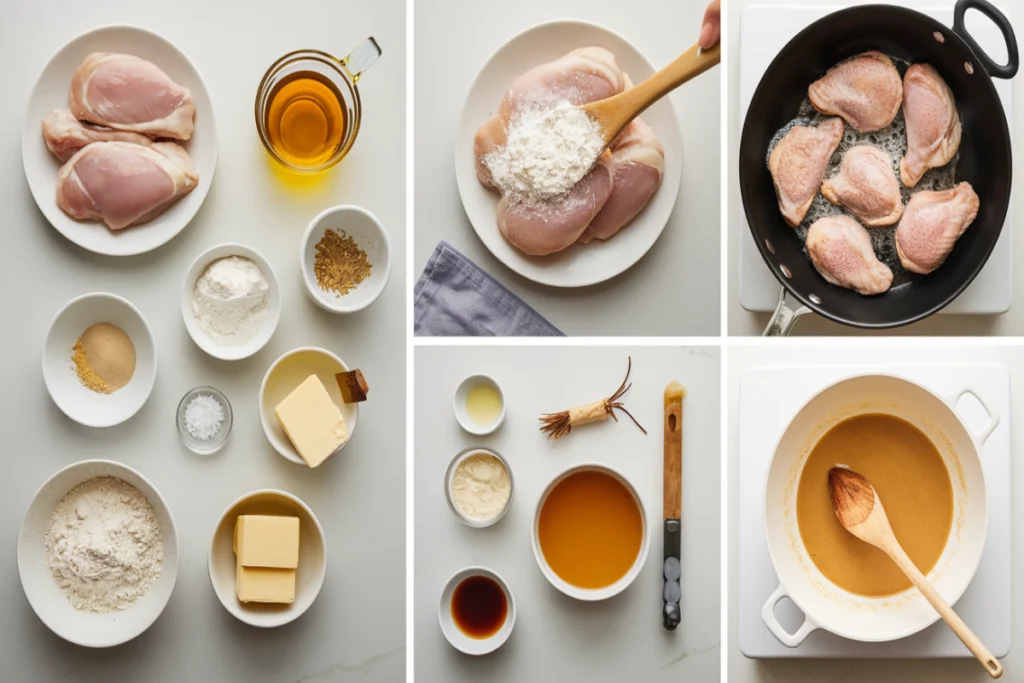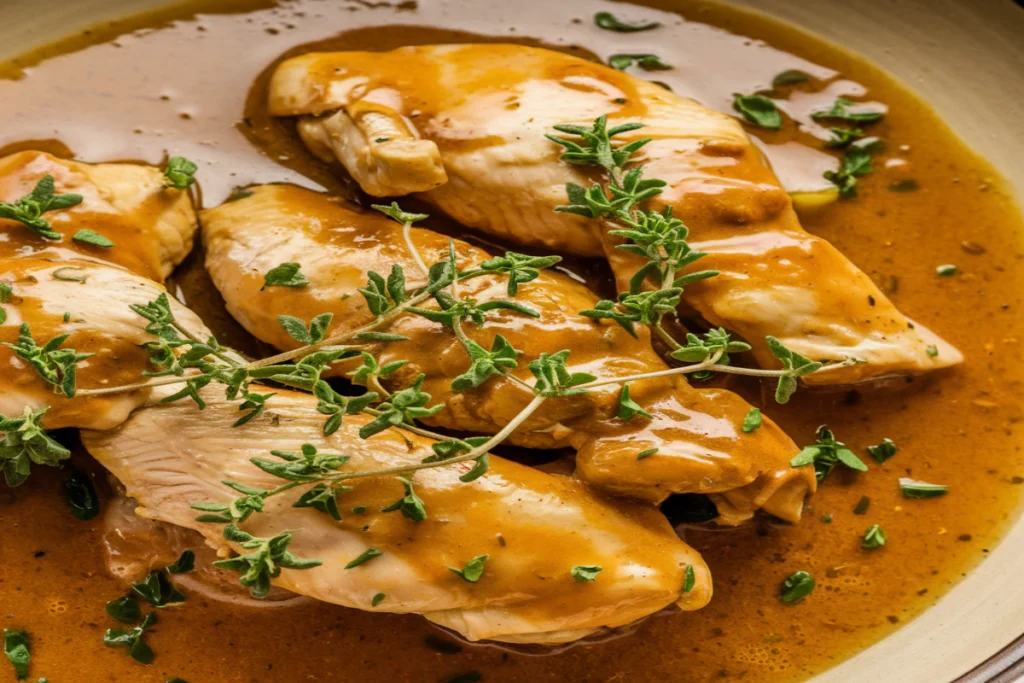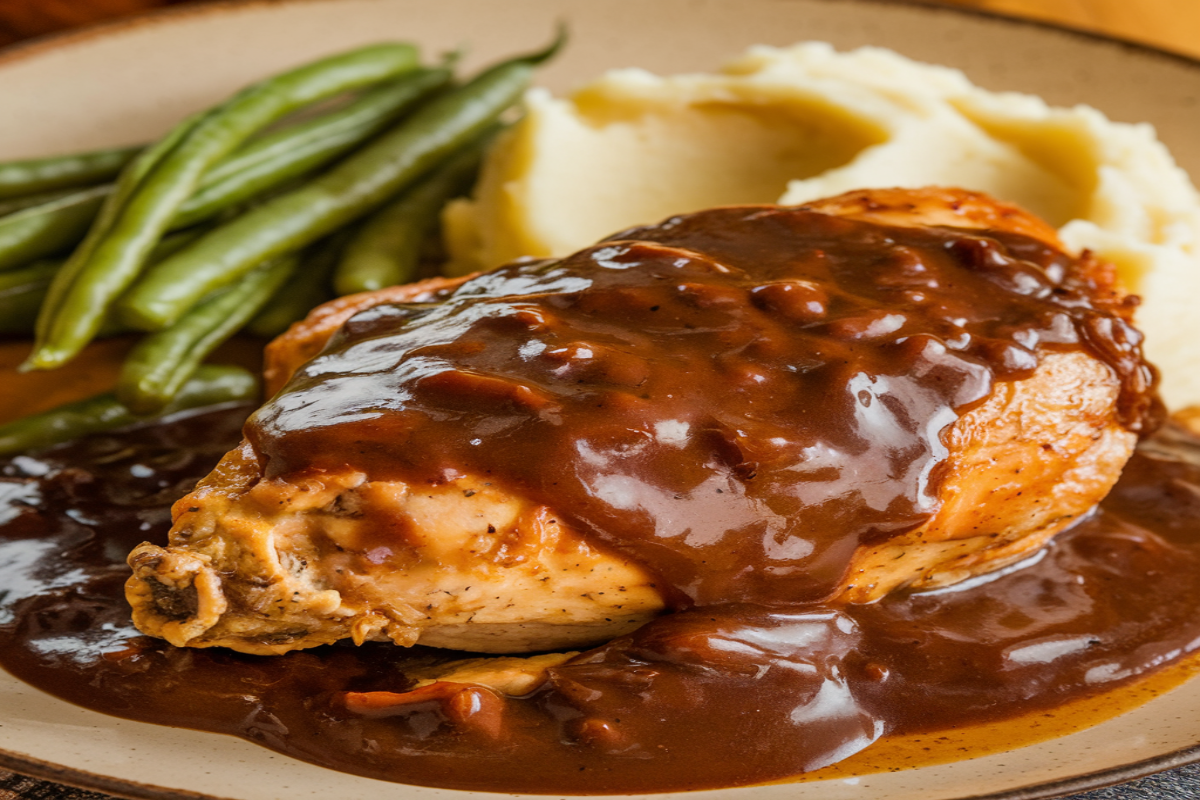If you’re craving a comforting and savory meal that satisfies your hunger and soul, look no further than Chicken and gravy recipe. This classic dish has stood the test of time, offering rich, flavorful gravy paired with tender, juicy chicken. Whether you’re preparing a weeknight dinner or a Sunday family meal, this recipe will deliver the perfect comfort food experience.
In this comprehensive guide, we’ll explore everything you need to know about making chicken and gravy from scratch. From selecting the best ingredients to mastering the gravy, you’ll have all the tools to create a dish that’s both satisfying and flavorful.
Ingredients and Tools Needed
Before diving into the recipe, let’s go over the essential ingredients and tools you’ll need to make chicken and gravy at home.
Essential Ingredients:
- Chicken: You can use various cuts, such as chicken thighs, breasts, or even a whole chicken, depending on your preference. If you’re interested in another chicken recipe, try this Ultimate Chicken Brine Recipe, which can make your chicken even juicier and more flavorful.
- Chicken broth or stock: Provides the base for the gravy.
- Flour: Used as a thickening agent for the gravy. Gluten-free options include cornstarch or arrowroot powder.
- Fat: Butter or oil helps create a roux for the gravy.
- Seasonings: Salt, pepper, garlic powder, and other herbs to enhance the flavor.
Recommended Kitchen Tools:
- Frying pan or skillet: Ideal for browning the chicken and making the gravy.
- Whisk: Helps ensure your gravy is smooth and lump-free.
- Spatula: Useful for flipping the chicken and stirring the gravy.
- Thermometer: Ensures the chicken is cooked to the right temperature.
When working with raw chicken, food safety is critical. It’s essential to follow safe handling practices to avoid cross-contamination and foodborne illnesses. For more information, check out the USDA’s safe chicken handling practices.
Preparing the Chicken

Now that we have the ingredients ready, it’s time to prepare the chicken. The key to tender and juicy chicken is proper preparation, and we will walk you through the steps to ensure your chicken turns out perfect every time.
Choosing the Right Chicken and gravy recipe
- Chicken thighs: These cuts are generally more forgiving and tend to stay juicier during cooking.
- Chicken breasts: Leaner and cook faster but require more careful attention to avoid drying out.
- Whole chicken: Offers the most flavor and versatility, but takes longer to cook.
Preparing the Chicken and gravy recipe
- Clean the chicken: Rinse the chicken under cold water and pat it dry with paper towels.
- Season generously: Rub the chicken with salt, pepper, and your choice of seasonings such as garlic powder, paprika, or thyme.
- Optional marinade: For added flavor, marinate the chicken in buttermilk, lemon juice, or a spice blend for at least 30 minutes.
Cooking Methods
- Frying: Heat oil or butter in a skillet over medium heat. Brown the chicken on both sides, ensuring a golden, crispy exterior.
- Baking: Preheat the oven to 375°F (190°C). Place the seasoned chicken in a baking dish and bake for 25-30 minutes, depending on the cut.
- Slow cooking: For tender, fall-off-the-bone chicken, cook on low for 4-6 hours in a slow cooker with broth and seasonings.
Using the right herbs can take your chicken to the next level. The Herb Society of America offers some excellent advice on choosing the best herbs for chicken dishes.
How to Make the Perfect Gravy

The gravy is the heart of this dish, transforming simple chicken into something rich and decadent. Homemade gravy might seem intimidating, but with a few simple steps, you can create a smooth and flavorful sauce.
Basics of Gravy Making
- Start with a roux: Melt butter or oil in the skillet over medium heat. Add flour and whisk continuously until the mixture turns golden brown. This is your roux, which will thicken the gravy.
- Add broth: Slowly pour in the Chicken and gravy recipe broth or stock while whisking. Continue to whisk to avoid lumps forming in the gravy.
- Season to taste: Add salt, pepper, and any other seasonings like garlic powder, thyme, or sage to enhance the flavor.
Thickening Techniques
- Using flour: The traditional method involves a flour-based roux. Whisking flour into the fat helps to create a smooth gravy.
- Cornstarch or arrowroot powder: If you need a gluten-free option, these can be used instead of flour. Simply dissolve the cornstarch in water before adding it to the broth.
Flavor Enhancement Tips
- Use drippings: After cooking the chicken, the flavorful drippings left in the pan can be added to the gravy for extra richness.
- Herbs and garlic: Fresh herbs like thyme, rosemary, or sage add a burst of freshness to the gravy, while garlic provides a deeper, savory flavor.
Common Gravy Mistakes to Avoid
- Lumpy gravy: Prevent lumps by whisking continuously and adding the liquid slowly.
- Too salty: Be mindful when seasoning the gravy, especially if your broth is already salted. Taste as you go to avoid over-seasoning.
Variations of Chicken and gravy recipe
One of the great things about chicken and gravy is its versatility. Whether you’re aiming for a classic Southern dish or experimenting with new flavors, there are plenty of ways to customize this meal.
Southern-Style Chicken and Gravy
Southern-style chicken and gravy is known for its rich and creamy texture, often served over buttermilk biscuits. To achieve this:
- Fry the chicken until crispy and golden, then use the drippings to make a flavorful roux.
- Add cream or milk to the gravy for extra creaminess.
- Season generously with black pepper for that classic Southern flavor.
Creamy Chicken and Gravy
For a creamier variation:
- Use dairy-based ingredients such as heavy cream or half-and-half in the gravy.
- Add mushrooms or onions for additional depth and texture.
- Serve the creamy gravy over mashed potatoes or egg noodles for a comforting meal.
Healthier Variations
If you’re looking for a healthier version of chicken and gravy:
- Opt for lean cuts like chicken breasts and use less oil in the cooking process.
- Use low-sodium broth to control the salt content.
- Substitute whole wheat flour or gluten-free options for the roux.
International Twists
You can also put an international spin on chicken and gravy:
- French-style: Add a splash of white wine and fresh herbs for a more sophisticated gravy.
- Asian-inspired: Use soy sauce, ginger, and garlic in the gravy for a savory and umami-packed dish.
Side Dishes to Pair with Chicken and Gravy
The right side dishes can elevate your chicken and gravy meal to a new level of deliciousness. Here are some classic and creative options to consider.
Classic Pairings
- Mashed potatoes: Creamy and buttery, mashed potatoes are a classic side dish that complements the rich gravy.
- Rice: Serve the chicken and gravy over fluffy white or brown rice for a hearty meal.
- Biscuits: Buttermilk biscuits are a Southern staple that pair perfectly with the savory gravy.
Vegetable Sides
- Green beans: Steamed or sautéed green beans add a fresh and crisp contrast to the richness of the dish.
- Roasted carrots: Sweet and caramelized roasted carrots provide a nice balance to the savory chicken and gravy.
- Steamed broccoli: A simple yet nutritious option that adds color and crunch to the plate.
Bread Options
- Buttermilk biscuits: Soft and fluffy, biscuits are perfect for soaking up every drop of gravy.
- Dinner rolls: Light and airy dinner rolls can be served warm alongside the chicken and gravy.
- Cornbread: For a slightly sweet and crumbly alternative, cornbread pairs beautifully with this dish.
Storing and Reheating Tips
If you have leftovers, chicken and gravy stores and reheats well, making it an excellent option for meal prepping or enjoying the next day.
Best Practices for Storing Leftovers
- Refrigerate: Store the chicken and gravy in an airtight container in the refrigerator for up to 3-4 days.
- Freeze: If you want to freeze the dish, allow it to cool completely, then transfer it to a freezer-safe container. It can be frozen for up to 3 months.
Reheating Techniques
- Reheat the chicken in the oven at 350°F (175°C) until heated through. Be careful not to overcook it, as this can dry out the chicken.
- Reheat the gravy on the stovetop over low heat, whisking occasionally to maintain a smooth consistency. Add a splash of broth or water if the gravy becomes too thick.
How Long Chicken and Gravy Can Be Stored
When properly stored, chicken and gravy can last in the refrigerator for 3-4 days or in the freezer for up to 3 months. If freezing, label the container with the date to ensure it’s used within the recommended timeframe.
Frequently Asked Questions
How Do I Thicken My Gravy Without Flour?
If you need to thicken your gravy without using flour:
- Cornstarch: Dissolve cornstarch in cold water and whisk it into the gravy.
- Arrowroot powder: Another gluten-free option that can be used in place of flour.
- Pureed vegetables: For a healthier alternative, try pureeing cooked vegetables like cauliflower or carrots and mixing them into the gravy.
Can I Make Chicken and Gravy Ahead of Time?
Yes, you can make chicken and gravy ahead of time:
- Prepare the chicken and gravy as usual, then store them separately in airtight containers.
- Reheat the chicken and gravy before serving, adding a splash of broth to the gravy if needed.
What Are the Best Chicken Cuts for Making Gravy?
- Chicken thighs: These are often the preferred cut for making gravy because of their rich flavor and tenderness.
- Chicken breasts: If you prefer a leaner option, chicken breasts work well, but be careful not to overcook them.
Can I Make This Dish with Leftover Chicken?
Yes, chicken and gravy can be made with leftover chicken:
- Shred or chop the leftover chicken and warm it in the gravy until heated through.
- This is a great way to repurpose roast chicken or rotisserie chicken.
How Do I Prevent the Gravy from Getting Lumpy?
To prevent lumps in your gravy:
- Whisk continuously while adding the liquid to the roux.
- Add the liquid slowly, allowing the roux to absorb it gradually.
Conclusion and Final Thoughts
Chicken and gravy is a timeless recipe that offers comfort and satisfaction in every bite. Whether you’re making it for the first time or perfecting your technique, this guide provides everything you need to create a delicious and memorable meal. From choosing the right chicken to mastering the gravy, the versatility of this dish allows you to customize it to your liking, ensuring there’s something for everyone.
With proper storage and reheating tips, you can enjoy chicken and gravy as a quick meal or even a leftover lunch. So, don’t hesitate to experiment with different variations and side dishes to find your favorite combination. By following these tips, you’ll be well on your way to making the perfect chicken and gravy every time.
